
You're going to need a reflow soldering station just to start, but I have n…
#AIRPORT EXTREME PORT FORWARDING UTILITY WINDOWS 8.1 MAC#
The utility will show each client MAC address, signal, noise level, rate, and what network mode they’re using. One of the features Airport Utility has that a lot of other consumer devices don’t is a nice way of viewing the status of attached wireless clients, including a little graph that continually tracks. I’ve experimented around and even a USB hub plugged in with devices attached to it works, so you’re not limited to just a single port. In addition to sharing disks, the Airports can also share printers attached using USB. That said, some of the options are a bit barebones compared to more enthusiast open source packages, but it gets the job done. If you run the devices as a router, you can also port forward, configure the DHCP server (including static addresses assigned to specific MACs), and all the usual fixings.

There’s honestly everything you’d want from a consumer level router or wireless AP, and a couple of extras like RADIUS server support and guest network creation. As an aside, if you’re going to set the 5GHz channel manually, select one over 149 to get maximum power and avoid dynamic frequency selection chanels in the US. Each of the radios (2.4 and 5GHz) can be set to its own SSID, there are a wide selection of radio modes and the ability to set channels manually. The rest of configuration is honestly pretty straightforward. The utility can also monitor for when problems happen. Status mirrors the front panel LED which either glows green or amber depending on whether things are working fine.įor example, when the Time Capsule starts overheating the LED blinks amber and pops up an alert. The first page is summary, which lists some basic information, status, and high level information. There’s either the choice to have a wizard set everything up, or you can do it manually. Admittedly that’s a nice touch that makes configuration super easy. It pops up a list of devices, including unconfigured ones without the need to connect over ethernet. On all of Apple’s WiFi products, Airport Utility is the exclusive point of configuration. There’s no web-based portal like just about every other attached network device. To start, all configuration is done through Airport Utility on OS X and Windows. I’m not going to go into very much detail at all about the network side of things (routing performance, etc.) since honestly nothing has changed here-the board and SoC are the exact same.

RDC allows you to save name these profiles separately.The only remaining thing to go over is the Airport Utility and general network functionality.

The "Computer:" name you will use in RDC away from your home network is the static IP assigned to your router by your ISP. The private IP address is the static IP of your Win machine. If you need a biginning and ending port just use the same one for both. Depending on your router, it may be easier to create your own "service" and just name it something like "MS RDC". You will need to set your router up in the appropriate configuration. The second one requires you to be able to configure your router to pass a RDC signal to your Win machine. Then you can create a profile to RDC your Win machine when you are at home (assuming you have only one home network) and another profile to connect through the Internet when you are away.įor the first one all you need to do is use the IP address of the Win machine in the "Computer:" name box of RDC when you are home. You should assign your Win machine a static IP address first.


 0 kommentar(er)
0 kommentar(er)
